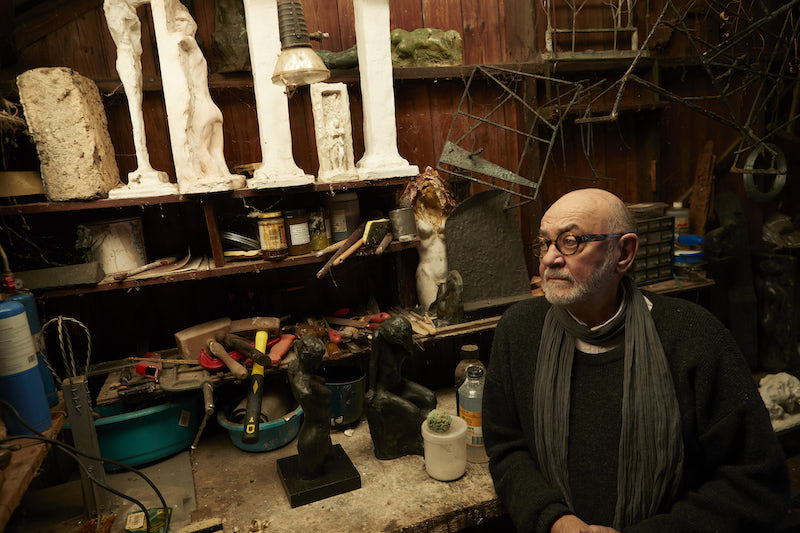Rick Amor: Enduring Presence
Over five decades of art making, Rick Amor has garnered the quiet respect of the art world.
Words: Sasha Grishin
Photography: Zan Wimberley
MELBOURNE-BASED FIGURATIVE artist Rick Amor has, over the past five decades, produced an extensive and consistent body of work, much of which is beautifully crafted, psychologically incisive, but has generally remained under the radar of the glitzy art world.
Amor was born in the Melbourne coastal city of Frankston in 1948 and received his earliest tuition at Caulfield Technical College under the painter Fred Cress. But it was at the National Gallery School, under John Brack, that he arrived at some of his most important decisions as an artist. Brack was not an artist who cloned disciples. But through his rigorous intellect, he set an agenda of key concerns that many artists, including Amor, would subsequently pursue in their work. For Amor, Brack also served as an example of the professional artist – the artist for whom painting was a cerebral rather than a cathartic experience; for whom draughtsmanship was a central ingredient; and who made well-crafted art objects that engaged with an urban reality and operated on a number of levels. Amor’s art was to have a strong social conscience and consciously reflected the heritage of both Brack and social realist, painter, printmaker, cartoonist and illustrator Noel Counihan.
Early in his career, Amor worked as a cartoonist and as a graphic artist for the left-wing and trade union press and produced a strong body of socially relevant work celebrating The Builders Labourers Federation workers and heroic physical labour. He also did some quite outstanding illustrations for the humanist writings of Alan Marshall. Throughout his life, Amor has produced a combination of paintings, drawings, prints, commissioned portraits and, since the late 1980s, sculptures, not a lot of which initially received much recognition from the art establishment.
In fact, it wasn’t until the late 1980s that Amor’s art seemed to find favour with the wider Australian art world, and with wealthy art patrons. Sell-out commercial exhibitions and critically acclaimed retrospectives followed. He has been the recipient of several Australia Council studio residencies that have taken him to London, New York and Barcelona. In 1999, he was appointed an Official Artist by the Australian War Memorial and sent to East Timor to cover the efforts of the Australian-led INTERFET forces. The resulting body of work received enormous publicity and wide acclaim. In 2001, a major monograph devoted to his life and art titled The Solitary Watcher: Rick Amor and His Art by Gary Catalano was published by Melbourne University Press. This was followed, several years later, by another monograph by Gavin Fry published by Beagle Press. An online catalogue raisonné of his print oeuvre by Irena Zdanowicz was launched in 2017.
Amor’s art defies simple classification, but it is united through palette and sensibility. At one stage he noted: “I use very dark tones. I worry about it a bit, but I think that the palette you have is the one you are given, and you have to live with that. My early life was anxious with family tensions. My mother died when I was young, and my father was distant. My landscapes are inhabited by isolated figures and people watching other people. It is not a self-conscious thing; it just seems to be the way I was meant to paint. The memory of unease and anxiety just comes to the surface. I dream about my childhood in the dark tonality of my paintings. The sky is always lowering into the sea, the beach is deserted and something awful has happened or is about to happen.”
In his hybrid and highly personalised form of urban Surrealism, Amor’s depicted situations are often deeply personal and autobiographical, but the record is intellectually distilled and reserved. Many of his works could be aligned with notions of the uncanny, Freud’s idea of das unheimliche – the unhomely, where the familiar can seem foreign, strange or uncomfortably familiar. Amor recently observed: “I like the slightly offside, rather than the uncanny; a sense of disquiet. Like in a dream when you see a familiar face that is not quite right – although I hardly ever paint things I’ve dreamt.”
Frequently, Amor’s paintings, prints and sculptures appear as enigmatic works – in the sense that this term may be applied to the work of Jeffrey Smart – where the viewer becomes involved in the complex situation before them. Many of his paintings are associated with moody urban landscapes: a dog standing on the edge of a dilapidated pier, boats rotting in the water, abandoned warehouses and displaced people marooned in a spiritual no-man’s land. Much of his imagery is about urban alienation, existential angst and the Balthus-like ambiguity of patterns of desire.
Perhaps the single most characteristic feature of Amor’s work is the sense of brooding introspection. Although there is tension and angst, it does not find expression through explosive energy, as was the case with a number of artists like Arthur Boyd, John Perceval and Albert Tucker. Instead, it seems to be subdued; observed from the outside in. Slowly but surely, we find ourselves immersed in Amor’s deeply complex world, where uncertainty reigns, and no one is sure who is actually watching who. It’s this enduring presence that prevails in both his art and his career, and has in turn placed him firmly within the canon of Australian contemporary art.
This article was originally published in Art Collector issue 85, JUL–SEPT 2018.









